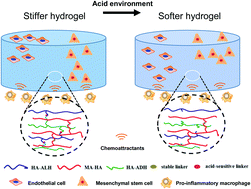Migration of endothelial cells and mesenchymal stem cells into hyaluronic acid hydrogels with different moduli under induction of pro-inflammatory macrophages†
Abstract
The design of hyaluronic acid (HA)-based and stimuli-responsive hydrogels to elicit highly controlled and tunable cell response and behaviors is a major field of interest in tissue engineering and regenerative medicine. The pH-responsive hydrogel can respond to pH variation during wound healing, which may in turn regulate the tissue regeneration process. In this study, a double-network hydrogel cross-linked with vinyl double bonds and Schiff base was prepared, whose properties were further adjusted by incubation in pH 7.4 and pH 5 buffers. The endothelial cells (ECs) migrated much deeper into the softer HA hydrogel pre-treated with pH 5 buffer than the stiffer hydrogel. By contrast, the mesenchymal stem cells (MSCs) migrated easily into the stiffer hydrogel. The ECs highly expressed RhoA and non-muscle myosin (NM) II genes in the softer hydrogel, which may facilitate amoeboid migration. Meanwhile, the MSCs were stiffer than the ECs, and highly expressed Rac1, RhoA, vinculin, NM II, hyaluronidase (HYAL) 2 and CD44 genes in the stiffer hydrogel, which facilitate mesenchymal migration. These results provide important clues for revealing the different migration strategies of the ECs and MSCs in HA hydrogels with different stiffness, and suggest that the mechanical properties and the network structure of hydrogels play an important role in regulating the three-dimensional migration process of these cells.



 Please wait while we load your content...
Please wait while we load your content...